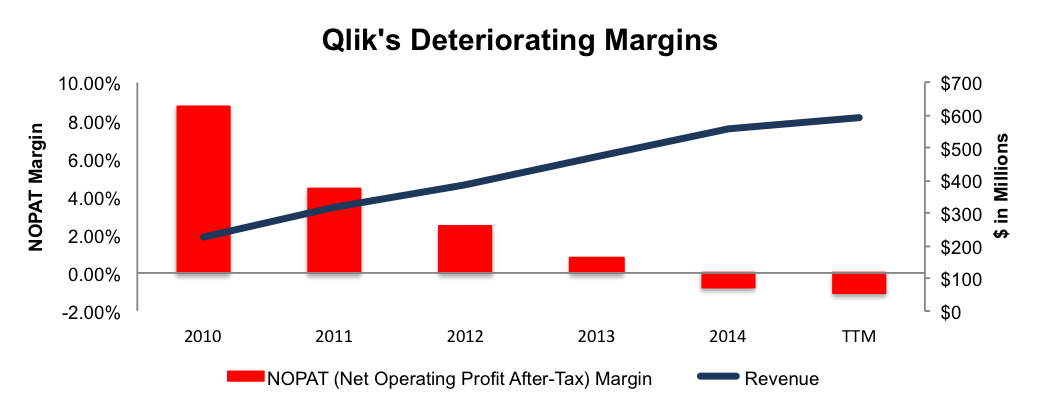Being slow to market, or failing to meet new customer demands can have a significant negative impact on a firms operations. In high growth and highly profitable industries, competition eventually enters the market and leaves those laggards behind. Despite deteriorating margins, lack of competitive advantage, and a sky-high valuation, Qlik Technologies (QLIK: $31/share) is up nearly 33% over the past two years and finds itself in the Danger Zone this week.

Qlik’s Profits Have Disappeared
Qlik went public in 2010, and in that year generated an after-tax profit (NOPAT) of $20 million. Since then, NOPAT has declined each year and reached -$6 million over the most recent trailing-twelve-months (TTM). This deterioration of profits has come amidst strong revenue growth, but unfortunately, as the business has expanded, it has become ever more costly to run. Figure 1 shows how Qlik’s NOPAT margins have declined from 9% in 2010 to -1% in the TTM.
Figure 1: Margin Destruction Offsets Revenue Growth

Sources: New Constructs, LLC and company filings
We mentioned strong revenue growth above, and Qlik has grown revenues by 25% compounded annually since 2010. However, the company’s cost of growing revenue, which includes cost of sales, sales & marketing, research & development, and general & administrative expenses have grown at 33%, 25%, 51%, and 32% compounded annually respectively over this same timeframe.
Following the same troubling trend is Qlik’s return on invested capital (ROIC), which has fallen from a once impressive 48% in 2010 to its current bottom quintile -5%. No matter which way you look at Qlik, it is clear to see that this once profitable business model has been deteriorating for quite some time as it has grown and faced tougher competition.
Competitors Have Surpassed Qlik
Qlik’s technology was built to allow enterprise users to visualize and analyze data in real-time. The company built a profitable niche in the business intelligence market by providing easy access to its product, Qlikview, and upselling customers who had seen the benefits of using Qlikview. However, as the business intelligence market grew, customers outside the traditional IT market required an easier, more user-friendly solution. Since Qlik operated with high profitability, it comes as no surprise that new competition arose from start-ups to industry stalwarts committing additional resources to develop similar products to new open-source programs. Qlik was slow to react, and only released its “non-IT” product in late 2014. As it stands now, Qlik’s ROIC of -5% ranks well below that of its competition. In such a highly competitive market and with the lowest profitability in its market, Qlik can ill afford to compete on price while keeping up with competition.
Figure 2: Qlik’s Profitability Is Lacking













Leave A Comment